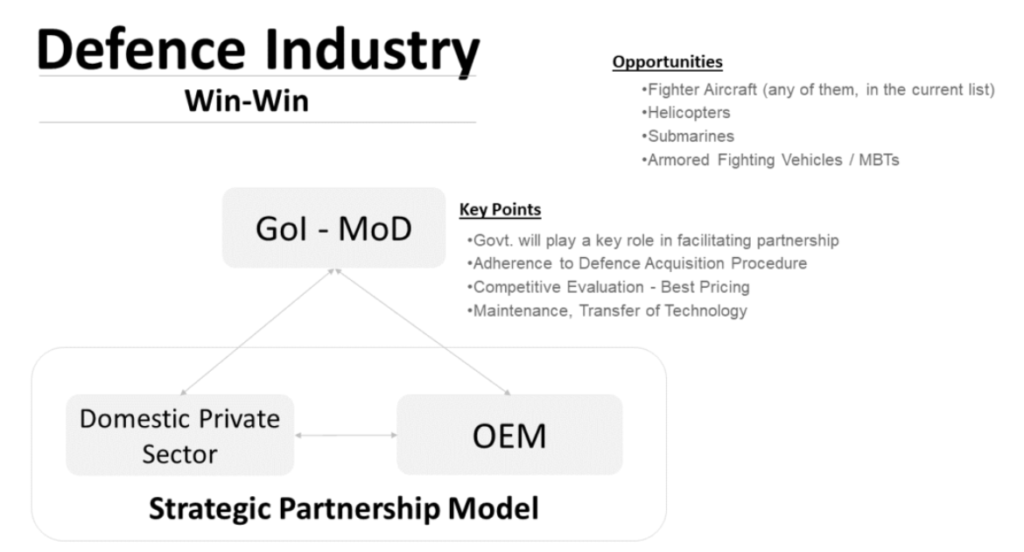Since Independence, India’s import bill has been to the tune of billions of dollars.
Consequences of these high level of imports?
- Pile up of stock due to unplanned imports [govt. said this clearly, in the DPEPP 2020 draft]
- Weak defence forces, more in number but weak in weapon systems
- Low morale of the armed forces, as they know the opponent, particularly on the north has a superior strength in short duration high intensity war
- Lack of respect due to porous borders
- Weak manufacturing base

What is the root cause of this mess?
It is the fundamental thinking that Indian entrepreneurs cannot undertake such projects, which was the opinion after independence.
So, the License Raj was born and the easier route of Imports was taken.
License Raj ensured that Indian entrepreneurs were dissuaded from aiming high.
License Raj died in 1991. Or did it?
No one in the Govt. knew, for nearly 20 long years, how to turn the corner, remove the cobwebs and replace it with comprehensive guidelines on the way forward to boost domestic defence manufacturing.
Now, in 2021 the Govt. of India has released the “Defence Acquisition Procedure” a detailed document from which there is no going back.
A deep analysis shows clearly, that the document has been prepared with foresight and by experts who have knowledge and expertise of how the acquisition (procurement) procedure system should work. Very positive, very encouraging.
The first question which arises is what is replacing the License Raj mindset?
The license raj is born out of the mindset “I am on top of the world looking down on creation”.
The Defence Acquisition Procedure 2021 is a complete reversal of that mindset.
Under the Macro certainty that the Govt. will purchase 300 weapon systems and sub systems from Indian manufacturers [200 announced by Ministry of Defence, 100 announced by DRDO], innovators (including patent holders) can now start working in all earnestness to design, develop and manufacture weapon systems, sub-assemblies and critical technologies.
So, what is holding back Indian businesses?
Technology to build such sophisticated and large systems, institutional memory to handle such large projects involving metal cutting, software, electronic and ammunition.
Of course, there are DPSUs which can handle such systems but private sector is many steps behind.
If private sector cannot handle such sophisticated weapon systems, is it the end of the road or has the Govt. thought this through?
As I was reading through the 680 page “Defence Acquisition Procedure” I was searching for an answer to this question as I have been disappointed many a times, when reading through Govt. documents.
That is till I came to the 7th Chapter of the Acquisition Procedure.
It is after reading this chapter, that I have added the phrase “There is no going back” in the title of this post.
Because, the Govt. has gone forward and taken the step, which no previous Govt. has taken.
Govt. has taken the leap and provided a solution and guidance to Indian Private Businesses.
The way forward given by the Govt. is the “Strategic Partnership Model“.
The singular purpose of this model is to enable Indian (domestic) Private Firms participate in Make In India while partnering with a foreign Original Equipment Manufacturer of weapon systems.
Let us understand how the Govt. intends to promote and take forward the initiative.
The first step is the MoD (Ministry of Defence) will shortlist OEM.
In the initial phase, SPs (strategic partners) in the following areas will be selected:
- Fighter Aircraft (any of them, in the current list)
- Helicopters
- Submarines
- Armoured Fighting Vehicles / MBTs
Private Companies in Defence Manufacturing will be given preference.
Private Companies will have to demonstrate capabilities of multi disciplinary functions, engineering and manufacturing, vendor networking.
Govt. to Govt. support for transfer of technology, IPR issues, will be provided.
Which are the Indian companies who can match up to the foreign OEMs? This question will be answered in my next article, and let us continue on our topic for the day.
Does all of this mean that Govt. will leave it to the Private Sector, more specifically to the Strategic Partner to figure out how to tie up with the OEM and sell to the Govt.
Absolutely, not.
And, this is heartening part.
The Govt. has a specific section in the Acquisition Procedure which deals with the role of the OEM in the “Strategic Partnership Model“.
- The OEM will have to form a JV with the Indian entity
- Alternatively, the OEM can have an equity partnership
- Royalty
- Technology sharing
SPM (Strategic Partner Model) from the OEM Perspective
For the OEM, it is a win win situation. Their product gets shortlisted, the OEM will get to participate and choose an Indian Private Partner.
From then on it is a question of how the OEM and Private Entity handles the process and as all parties have an investment, things can be expected to happen equitably.
The MoD will take an active role till the point of evaluating OEMs and tying up with an Indian Partner.
A contentious issue would be the “Transfer of Technology” clause.
DAP deals with this topic briefly in topic no.31 on page 502.
The Govt. has wisely not put any pre-conditions and has recognized that TOT comes at a high price. It is mainly concerned with life cycle support for the equipment, and TOT for providing this service.
This is very important – the paper does not talk about TOT to make the complete equipment indigenously.

Given the above the following is very clear:
- The Govt. is very much interested in boosting domestic defence industry and it is ready to play an active role
- The Govt. recognizes that domestic industry is not well equipped to manufacture large defence equipment
- The Govt. recognizes that domestic private sector needs strategic partnership with OEMs in foreign countries
- The Govt. is creating a level playing field which DPSUs and Private Sector companies. Together they are called as System Integrators
- The Govt. is keen to play a facilitator role and seems to be ready to the role, given the preparation which has gone into the effort
- The Govt. recognizes that the interests of the OEM has to be protected too
- The Govt. recognizes that it has to be transparent and committed – AON are the reference document to get things moving.
- The Govt. wants to ensure that its interests are protected. So long term maintenance contracts will include TOT to ensure the domestic partner can undertake maintenance.
- The Govt. intends to include sub contractors to boost domestic businesses. So, the Indian partner has to demonstrate a track record of providing orders to domestic sub contractors.
My Observations
- This is a big opportunity. There has been no history of the Govt. having taken an active role to support Domestic Defence Industry.
- Private sector should grab this opportunity.
- Strategic Partnership is a win win for all three.
- Rapid scaling up is possible.
- Doing the whole process on own initiative for private sector will be difficult and expensive.
Let’s together make India safe for us and our children.
So, do support by commenting, sharing on your whatsapp and linkedin walls.

